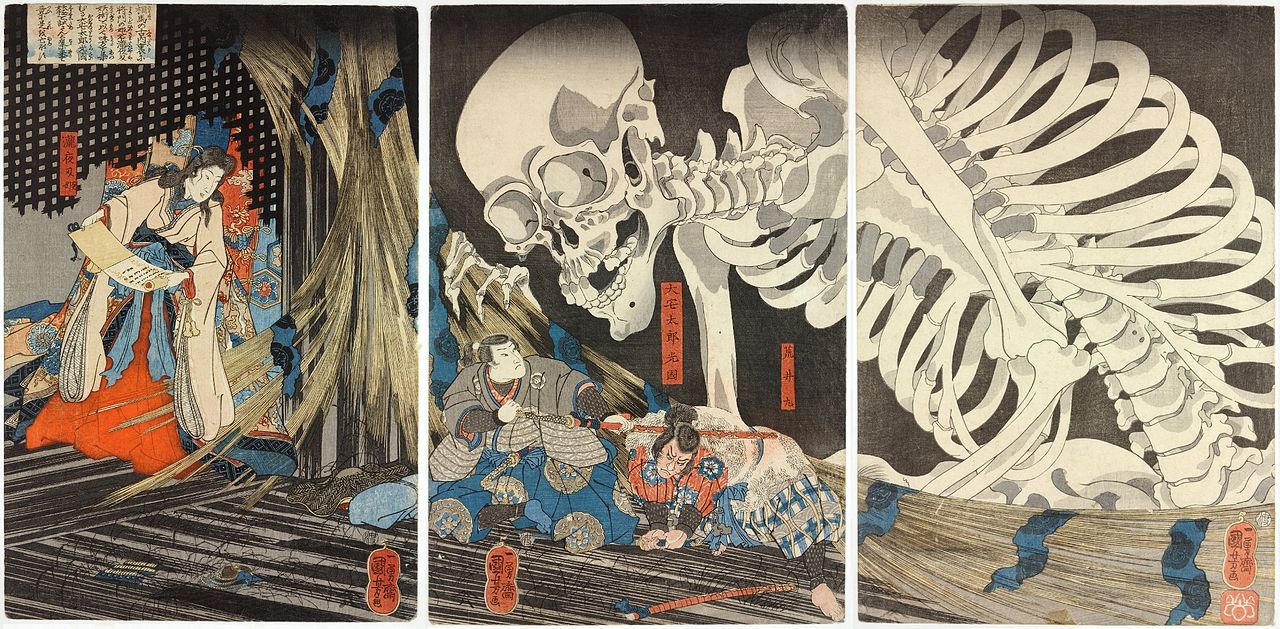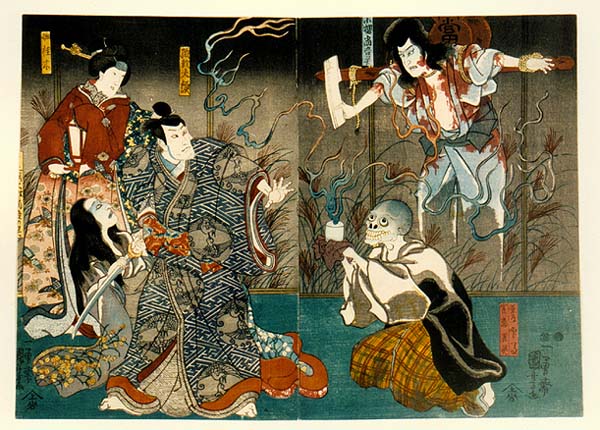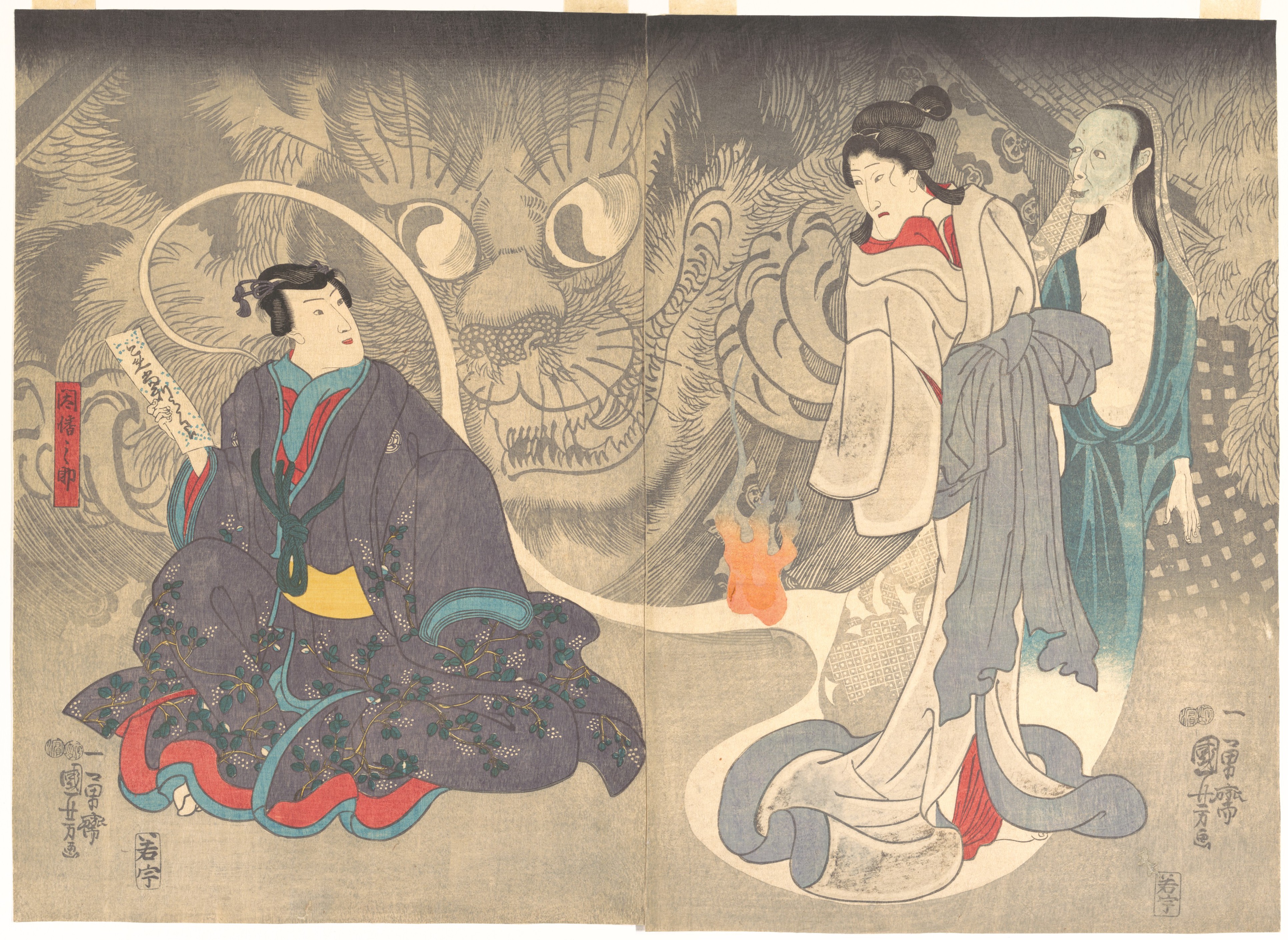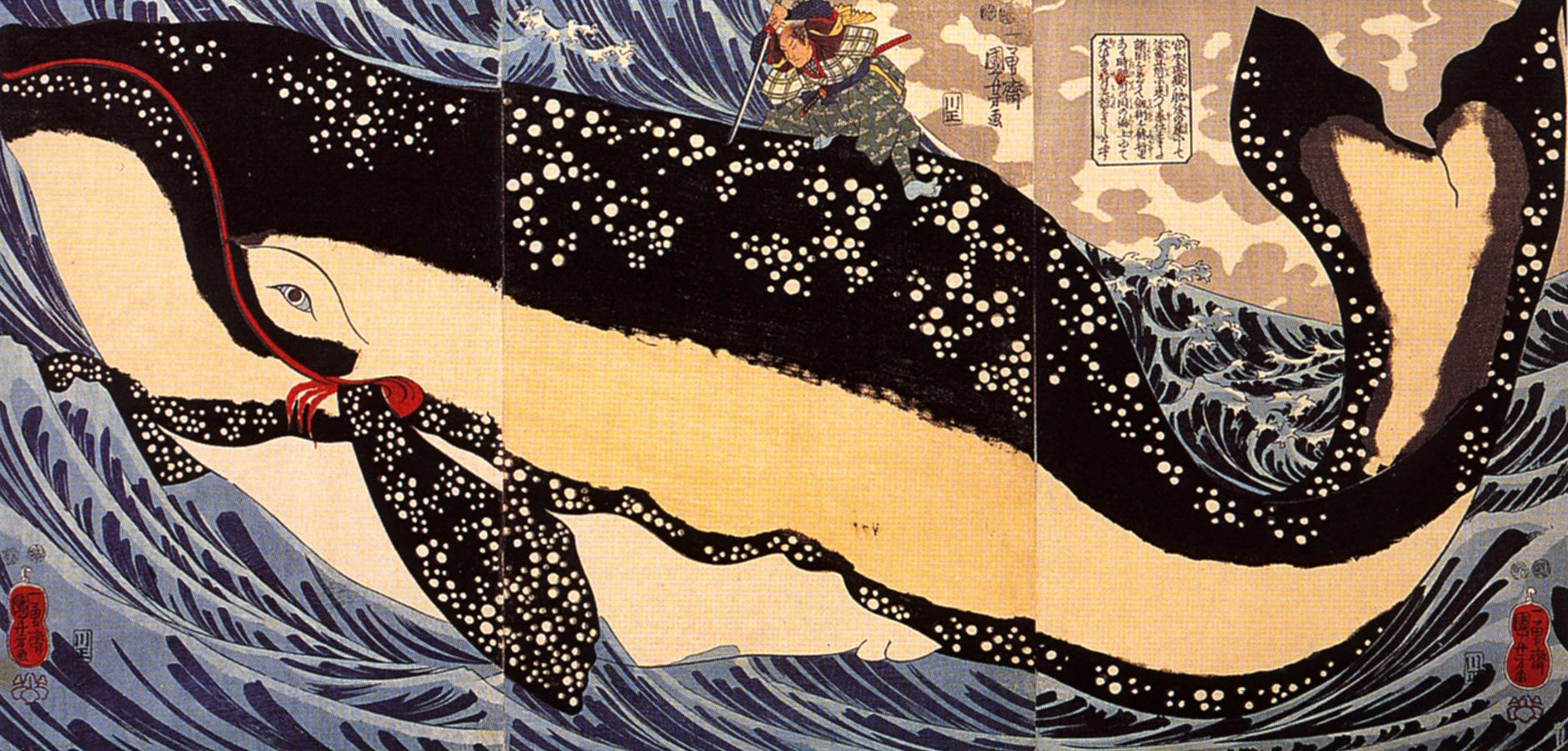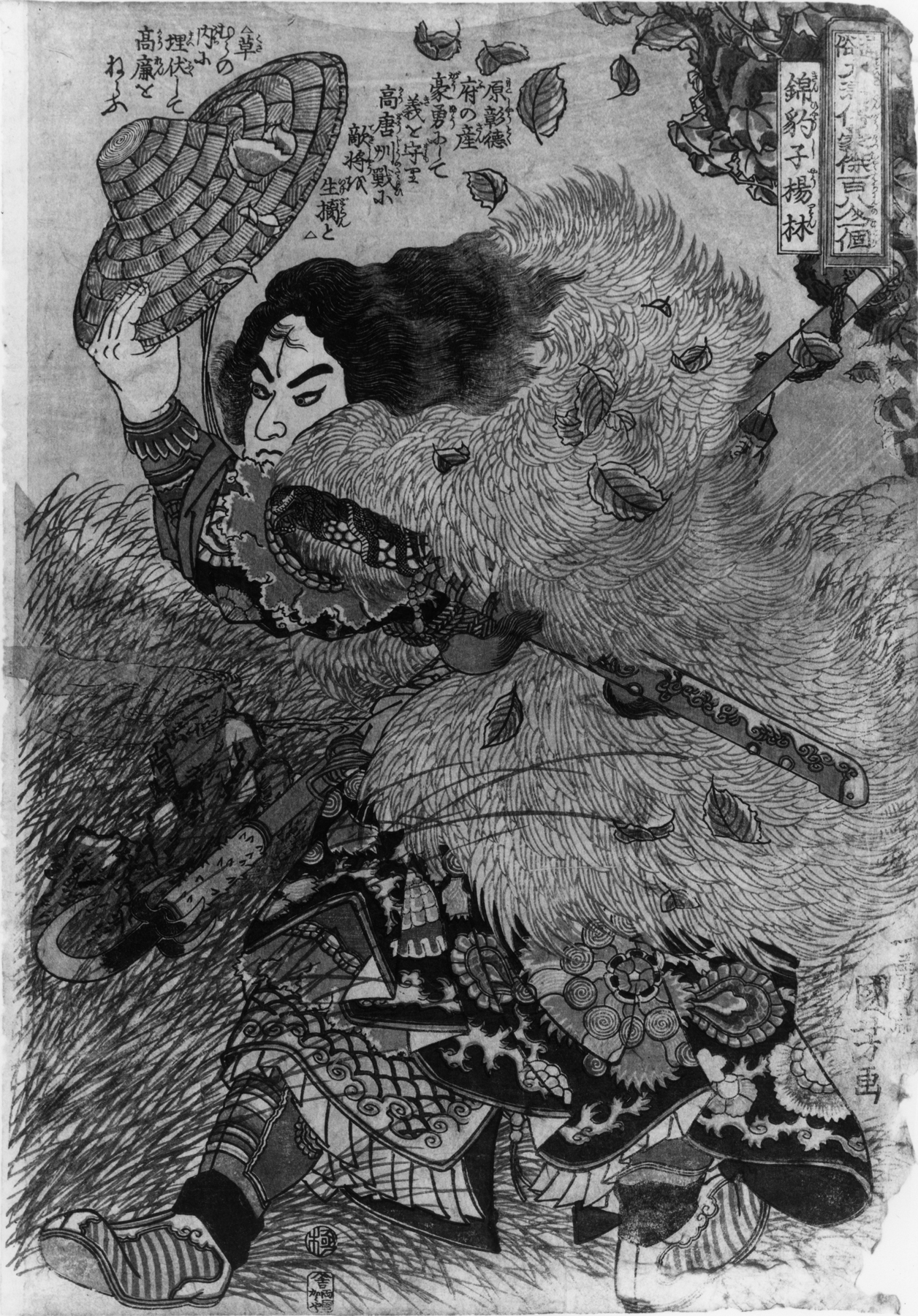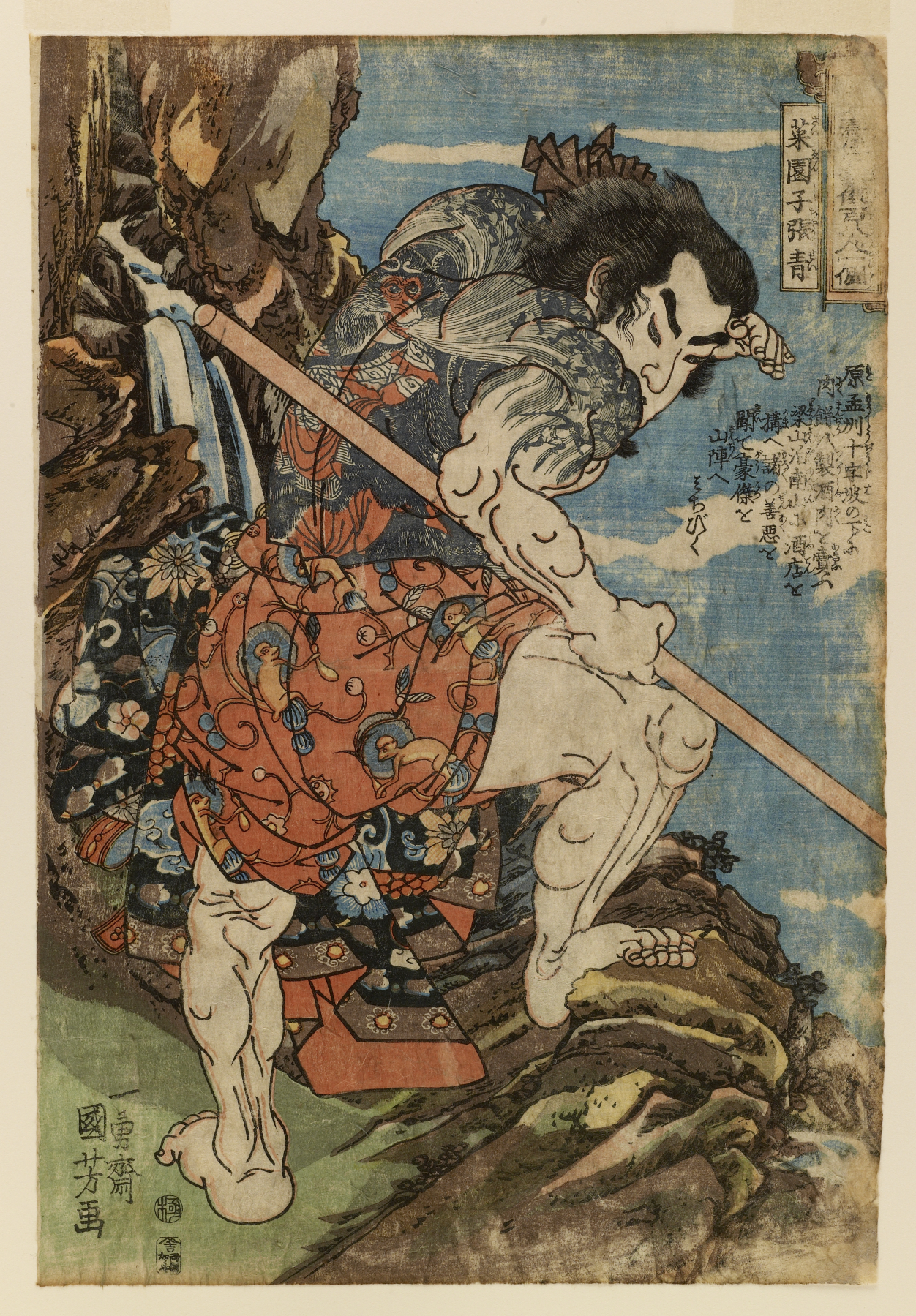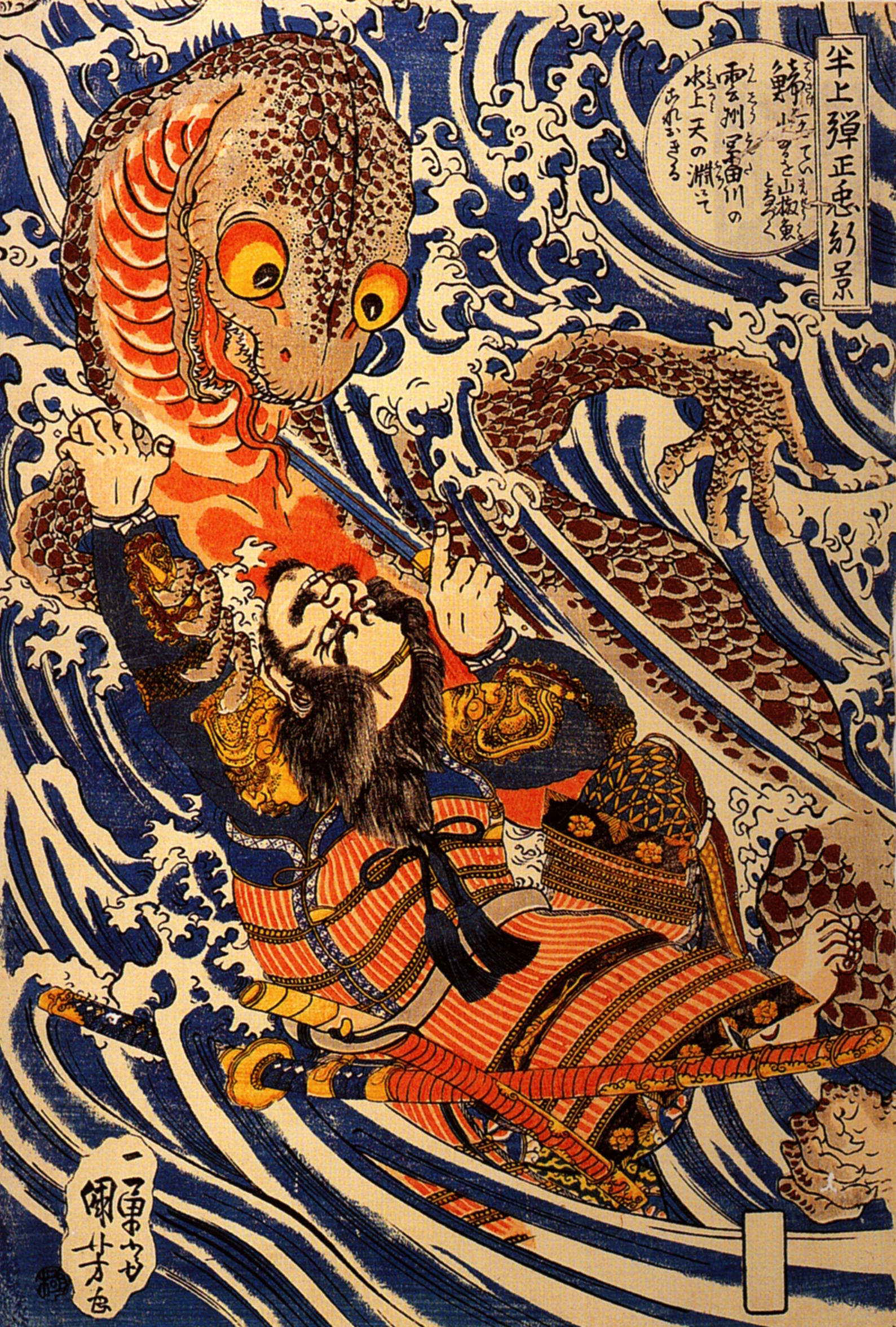Utagawa Kuniyoshi (Japanese, January 1, 1797 – April 14, 1861) created ukiyo-e woodblock prints in Japan’s late Edo period (1603 – 1868). The prolific Kuniyoshi, a contemporary of Hokusai, notable for his mesmerising “Great Wave”, was a master of the “Floating World” school. Kuniyoshi was more into derring-do than mellow lanscapes. His energetic, languid, bold and flowing depictions of muscular warriors, active death, fights with heavy weapons, far-out monsters and legends are spellbinding. His skeleton triptych (below) is wide-screen horror in lurid color.
“Some of his images are very violent,” says Arthur R Miller, a Kuniyoshi collector. “There’s a lot of Japanese legend there. But essentially his figures have a similar appeal to the toy soldiers we played with as children.”
The images are fresh and full of action. Kuniyoshi’s work was mass-produced, meant to be enjoyed by everyone, not stilted and packaged to the knowing as high-culture. These pictures are what great art is meant to be: fresh, innovative and accessible to all.

The Sea Monk (Umi Bozu) is a sea monster with a smooth round head, like the shaven head of a Buddhist monk. This woodblock print illustrates the story of the sailor Kawanaya Tokuzo, who decides to go to sea on the last day of the year, which other sailors consider unlucky. A violent storm breaks out, and the Umi Bozu appears. In a ghastly voice the apparition demands, “Name the most horrible thing you know!” Tokuzo yells back, “My profession is the most horrible thing I know!” The monster is apparently satisfied with this answer and disappears along with the storm.
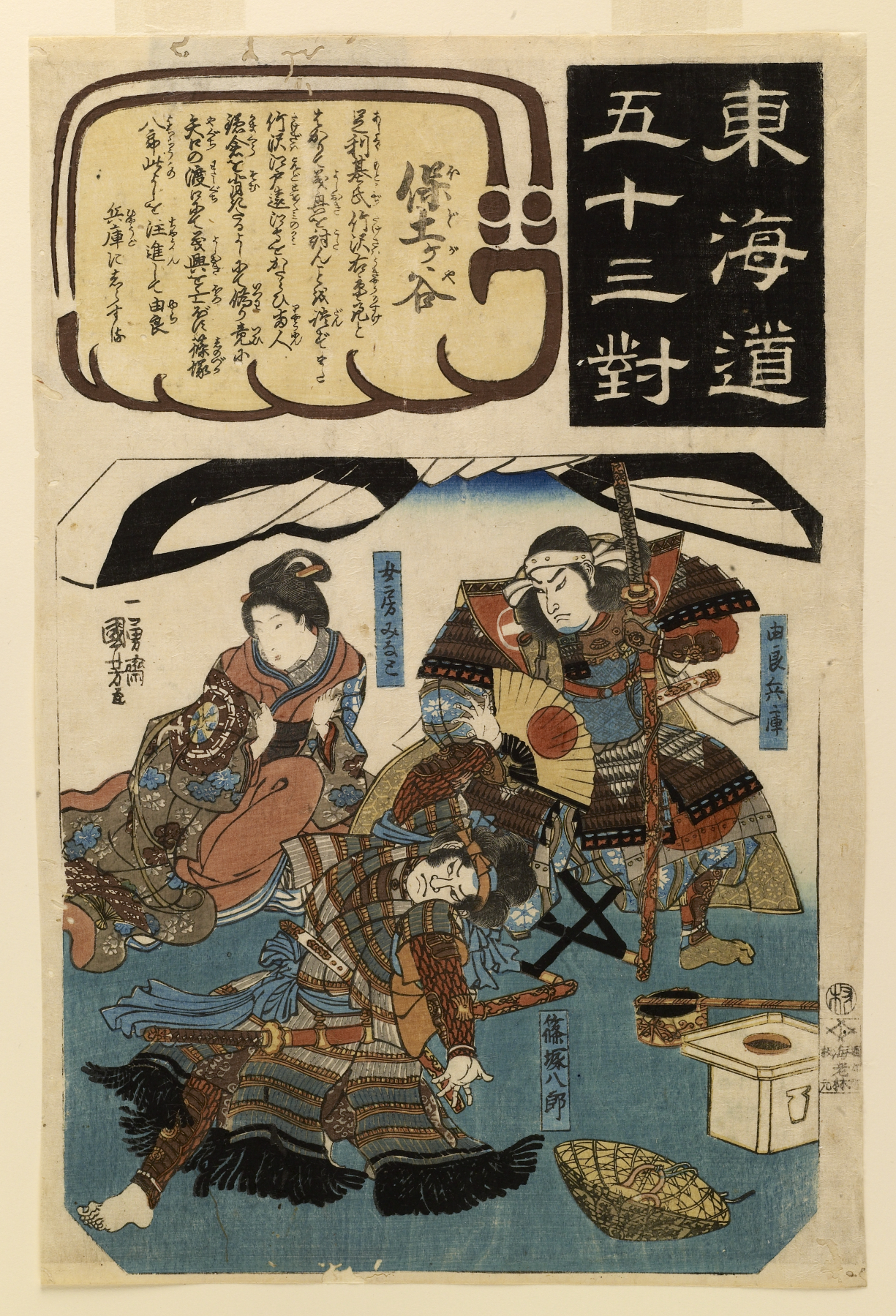
Expecting orders from his warlord Nitta Yoshioki, Yura Hyogo is shown seated inside his military camp near Hodogaya in 1358. The messenger before him brings bad news: Yoshioki is dead, betrayed by a former retainer. The messenger appears to be acting out the final moments when, in a sinking boat and under a barrage of arrows, Yoshioki honorably performed “seppuku” (ritual suicide).

In this design, one of Kuniyoshi’s greatest triptychs, he combines two of his most beloved and prolific subjects: warriors and ghosts. The historical general Minamoto Yoshitsune is commanding a fleet across Daimotsu Bay, just as an enormous storm begins to gather over the water. Suddenly, as a great wave swells under the hull of the boat, threatening to overtake them, the storm clouds transform into the ghosts of Yoshitsune’s defeated enemies.

The last stand of the Kusunoki at Shijonawate, Shijonawate nite Nanke no eiyu taiteki o. Shows the final battle of Shijonawate in 1348 with Kusunoki Masatsura, the son of Kusunoki Masashige, under a deluge of arrows continuing his father’s struggle against the Ashikaga forces. This forms a 6-sheet composition with another triptych and Kuniyoshi also designed another triptych of the same subject. Published 1847. Unidentified publisher.
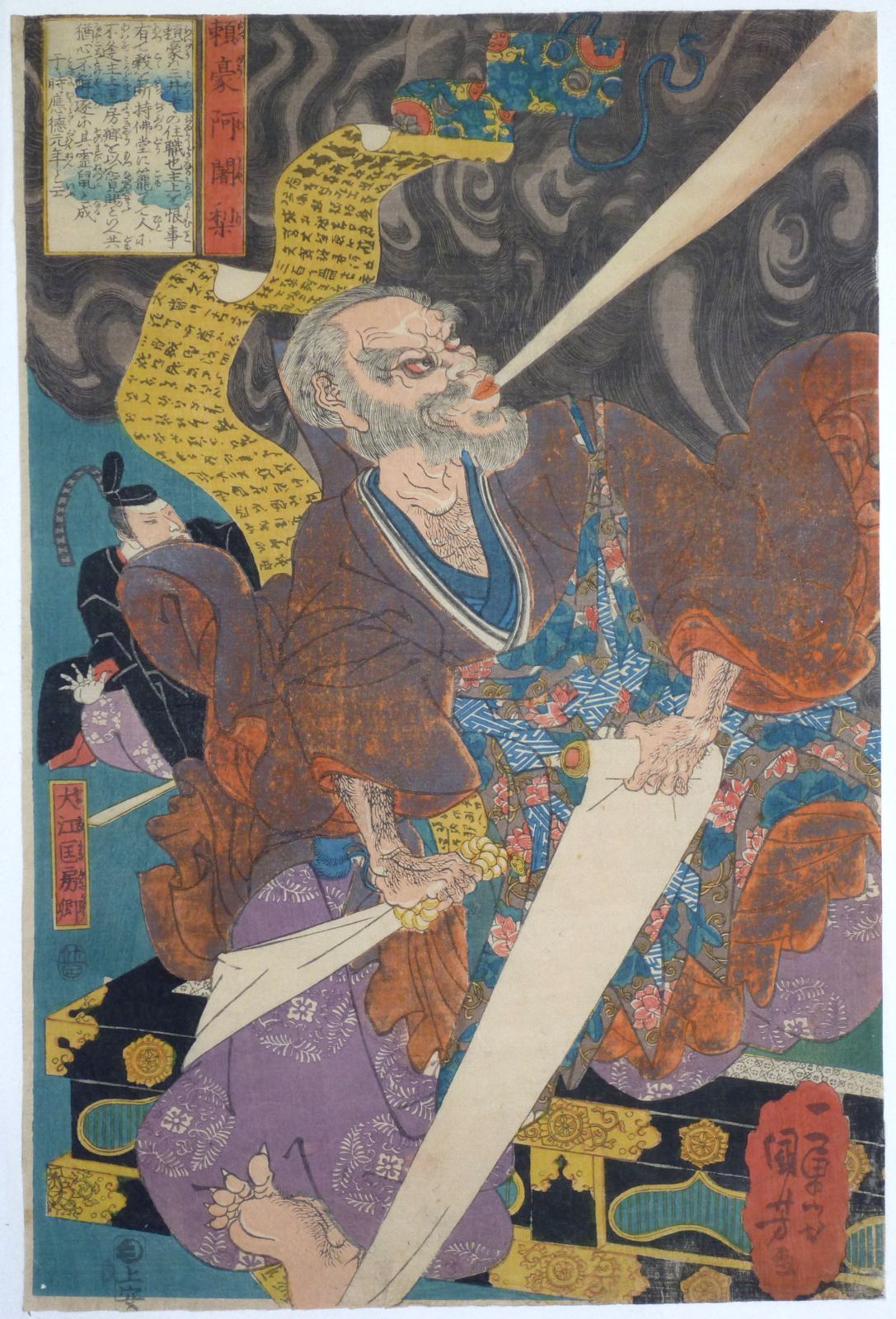
An early design of a famous episode depicting Raigo Ajari ( the priest Jitsusobo ) breathing out his curses and tearing up the Buddhist scrolls of Miidera Temple. His curses are directed at the Emperor Shirakawa who had refused the granting of a favour to build a praying platform at his temple in return for Raigo praying successfully for a son for the Emperor. Published by Jo-Yasu, c 1843. Robinson S1f.5. A fine and rare design.
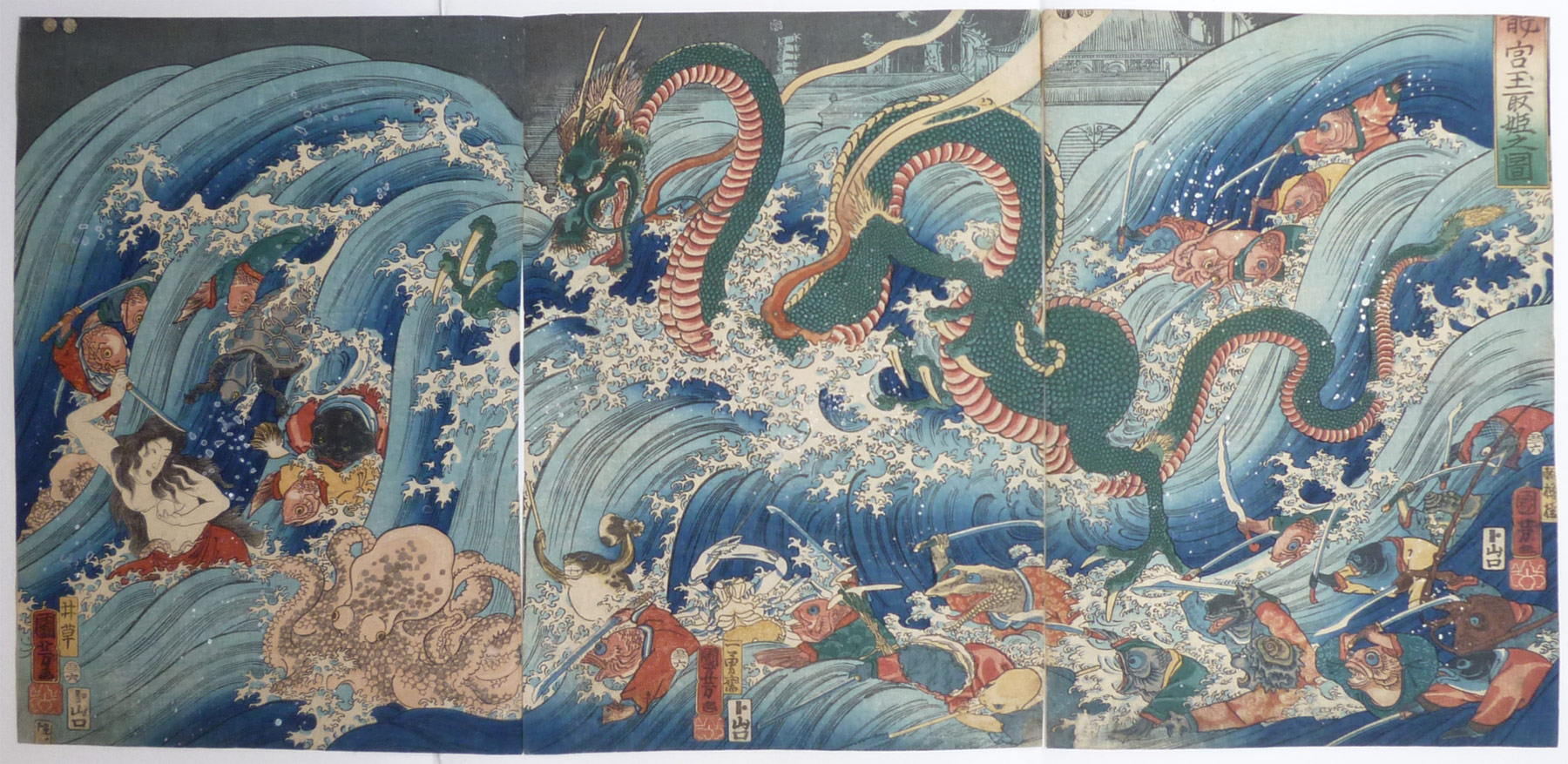
Tamatori-hime stealing the sacred jewel from the Dragon King’s Palace, Ryugu Tamatori-hime no zu. Published by Yamaguchiya Tobei, Ox 6, 1853. The ama is shown being pursued by the Dragon King and his various fishy retainers. This was a favourite subject of Kuniyoshi’s and he designed a number of triptychs and single sheets.
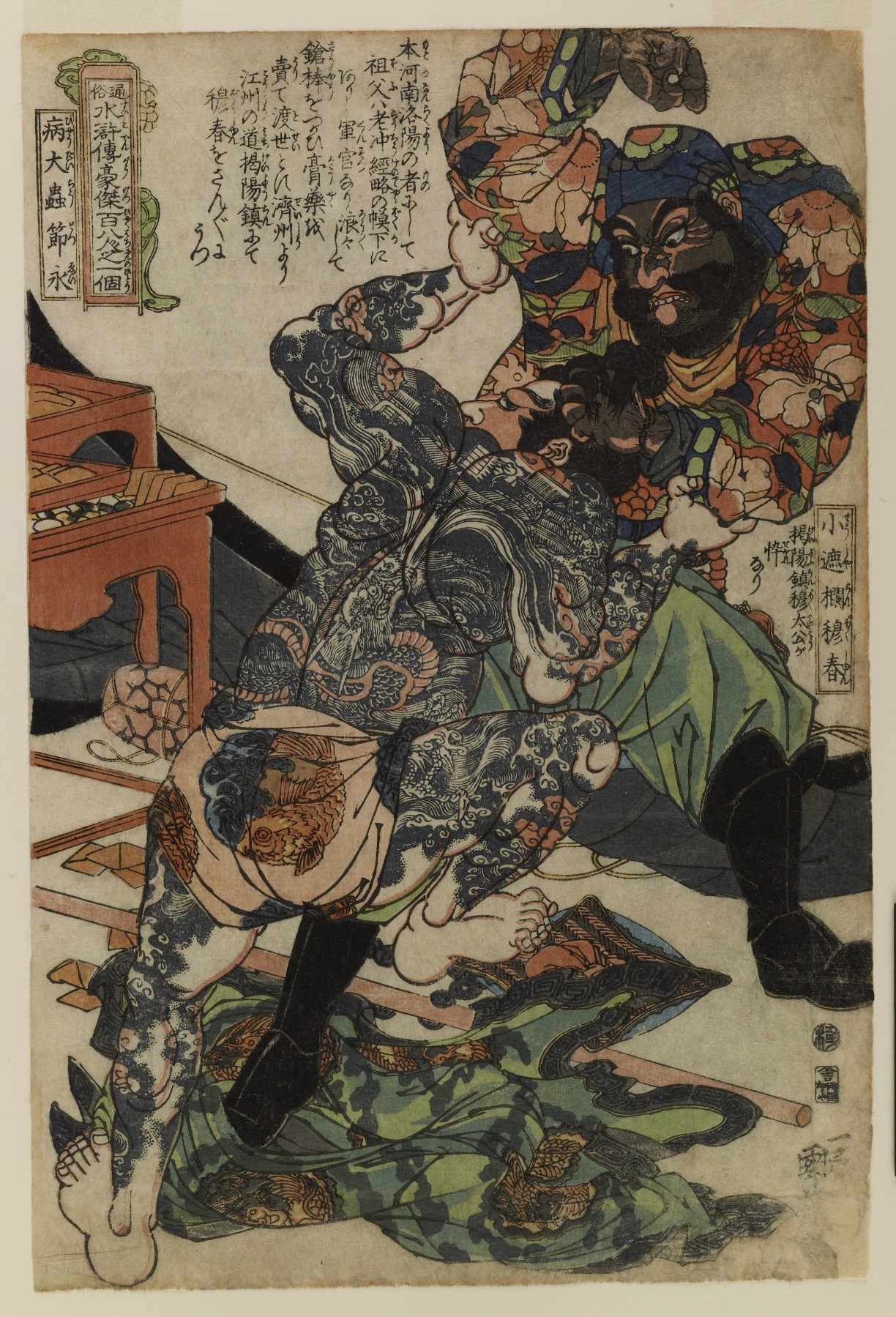
Byotaichu Setsuei, half-naked and tattooed with a dragon, fights bare-fisted with Shosharan Bokushun.
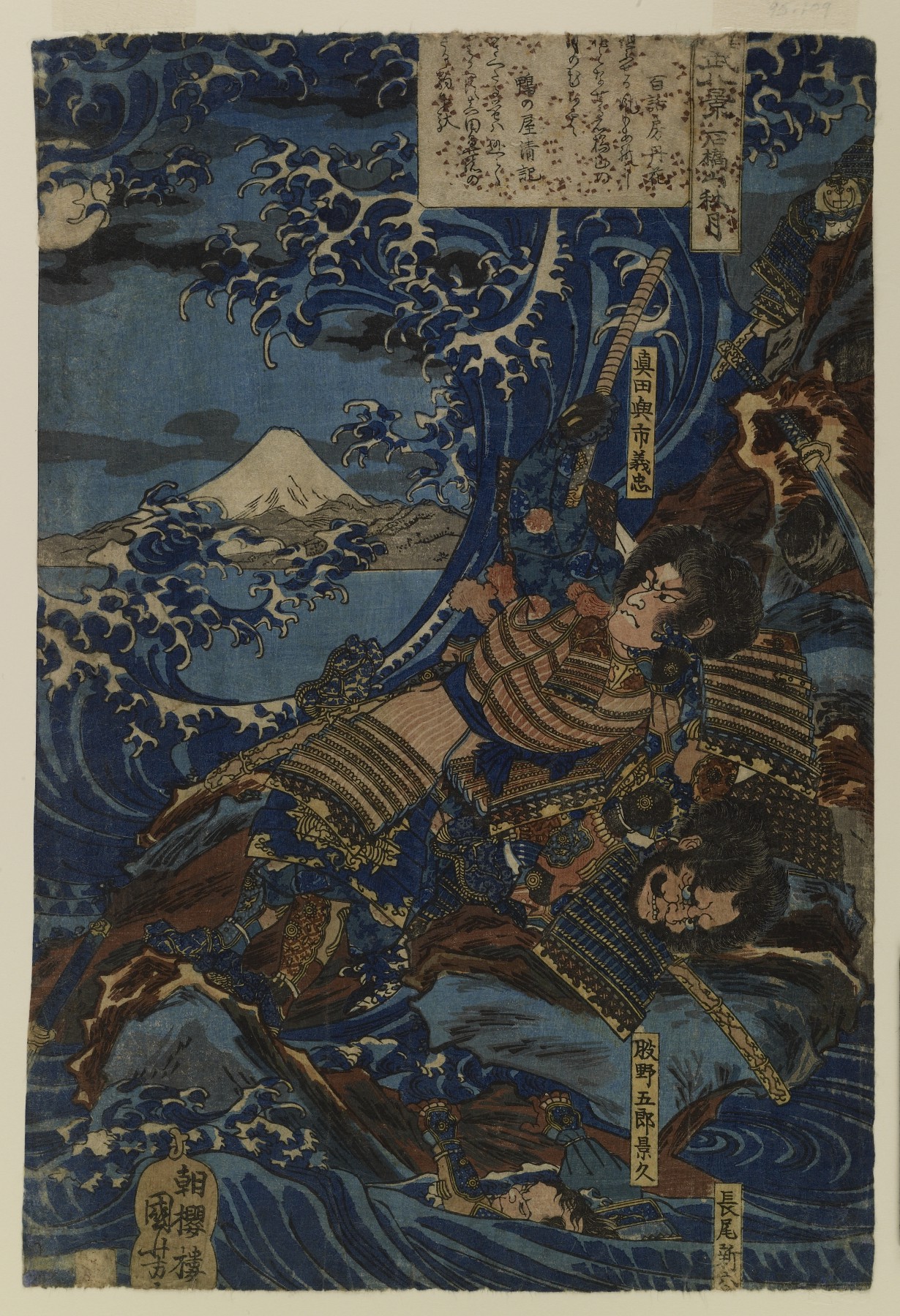
Heike and Genji forces clash on the rocky shore at Ishibashiyama within sight of a moonlit Mt. Fuji. The Genji warrior Sanada Yoshitada (top) seems to have the upper hand, but Matano Kagehisa will soon be aided by others, who will help secure victory for the Heike side.
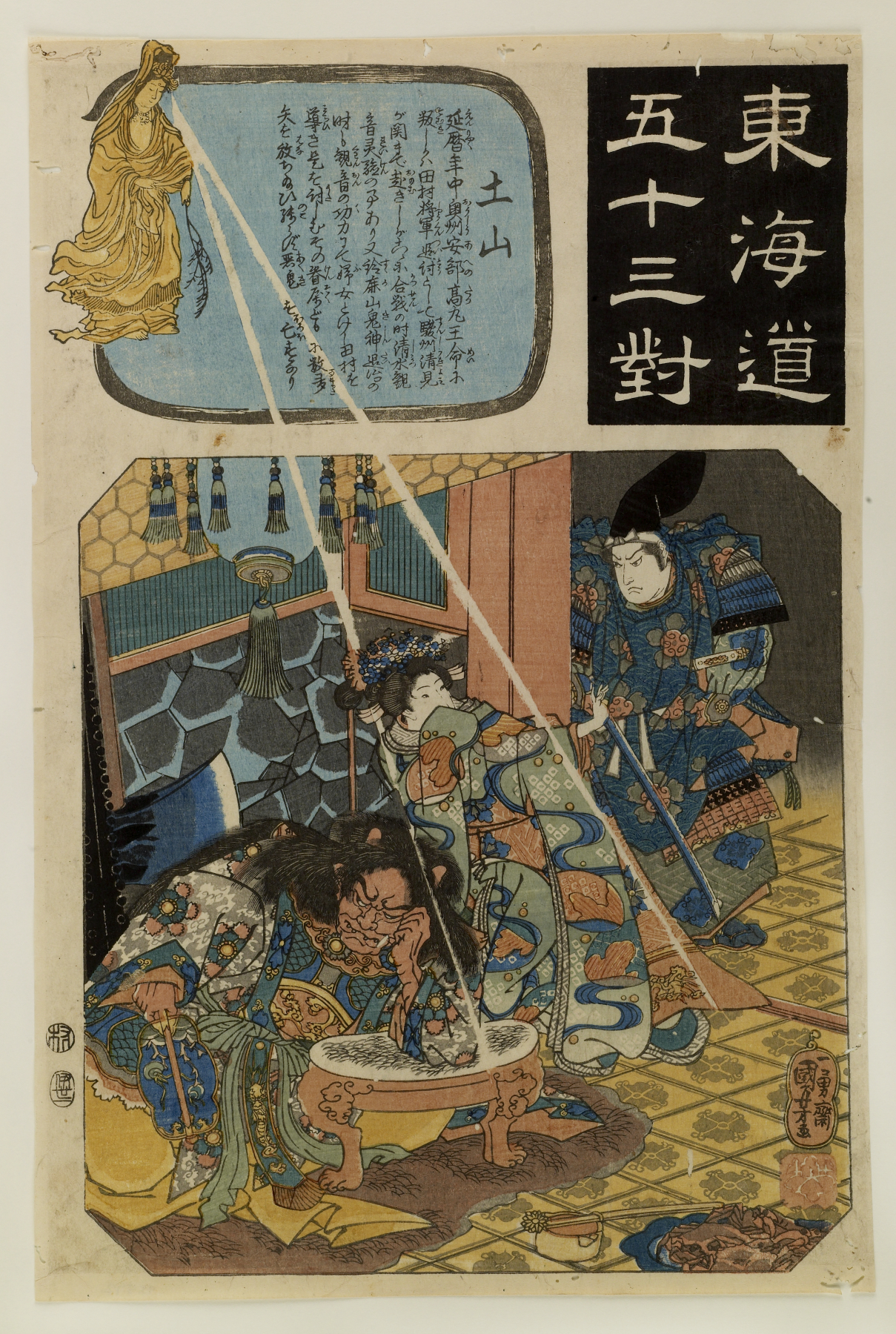
This print depicts Sakanoe Tamuramro (Tamura Shogun) who, directed by Kannon in the form of a woman, is about to kill the demon of Mt. Suzuka. The upper part of the print is the title of the series in large formal characters reserved in a black rectangle; on the left is a decorative panel with the name of the post-station and a short text.
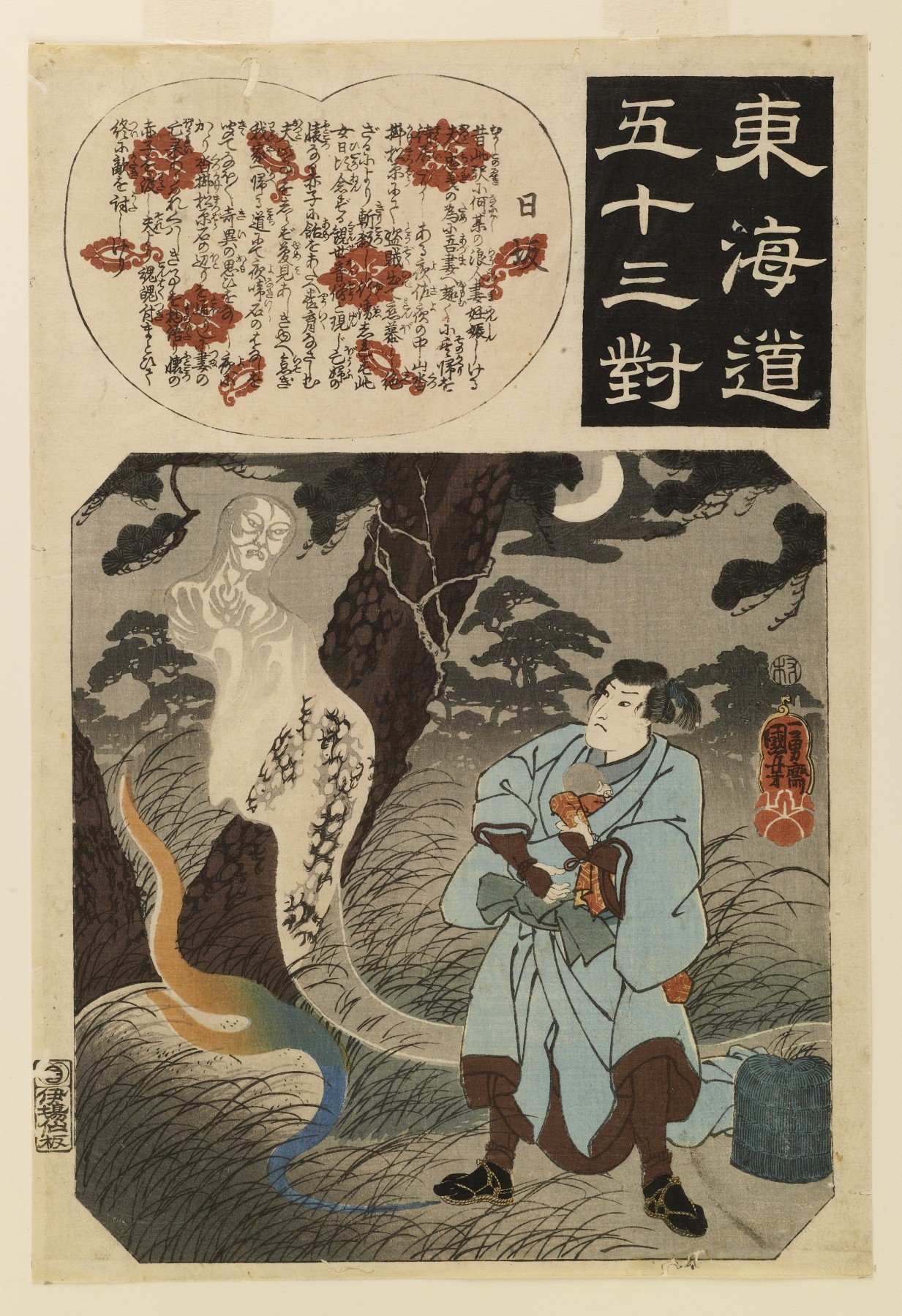
As a husband passes by the place where his pregnant wife was brutally murdered, her ghost appears and hands their child to him. She then tells him the story of her murder and assists him as he takes revenge for her death.
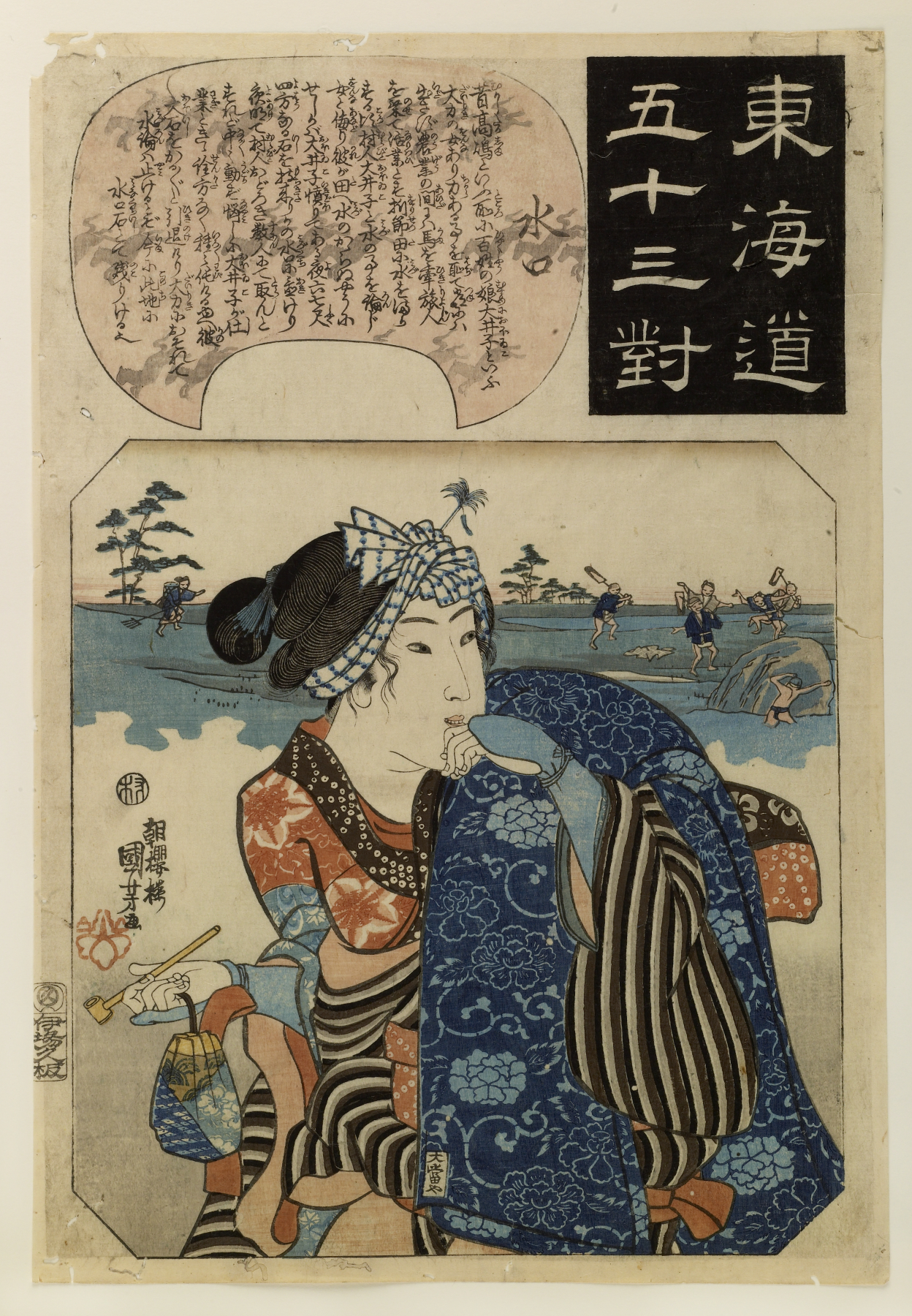
This print depicts the strong woman Oiko. In the background are peasants marvelling at the great rock which she dammed the river with. The upper part of the print is the title of the series in large formal characters reserved in a black rectangle; on the left is a decorative panel with the name of the post-station and a short text.
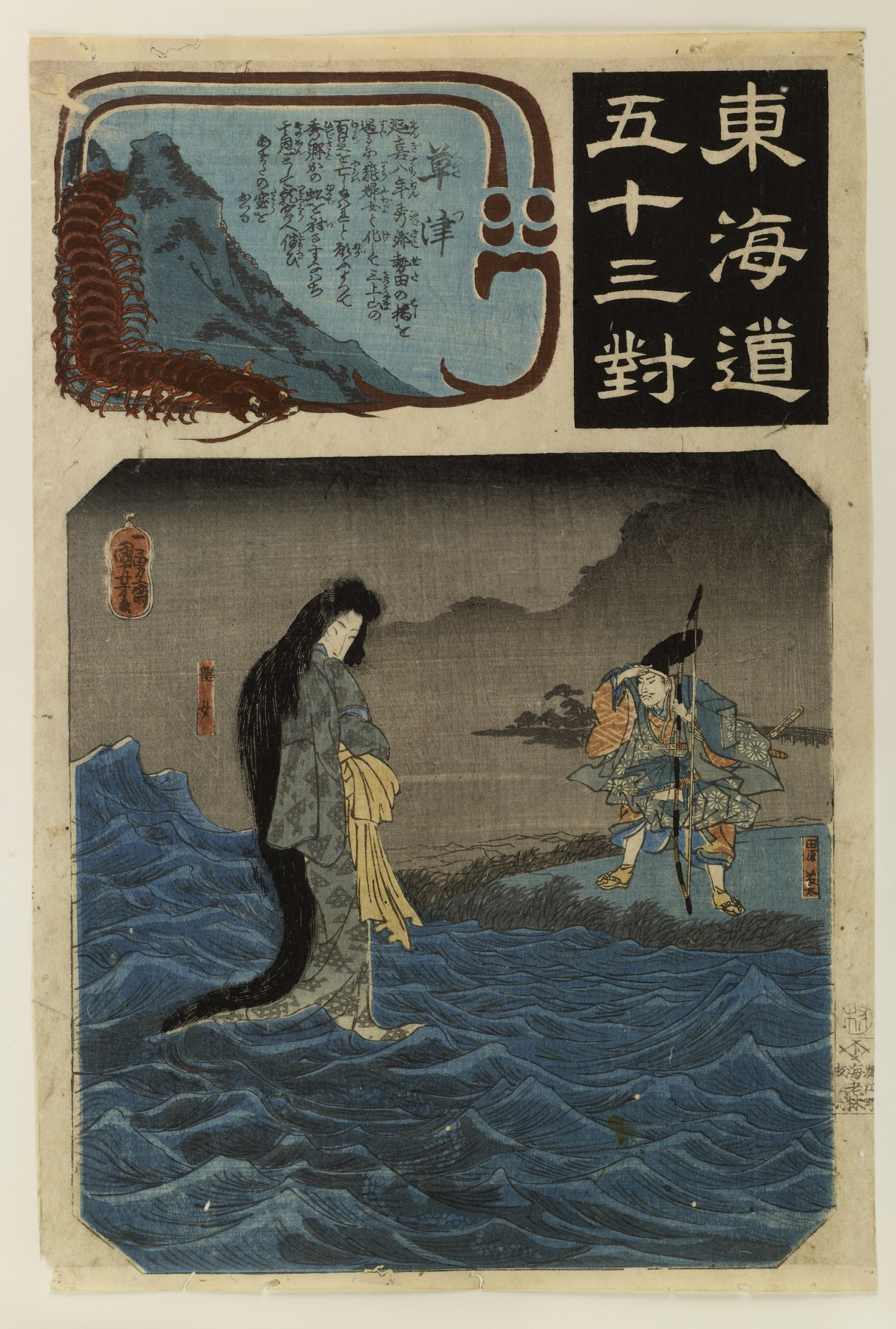
Tawara Toda (Fujiwara Hidesato) on the shore of Lake Biwa with his bow watches the Dragon Princess arise from the water. She is asking him to destroy the giant centipede of Seta. The upper part of the print is the title of the series in large formal characters reserved in a black rectangle; on the left is a decorative panel with the name of the post-station and a short text.
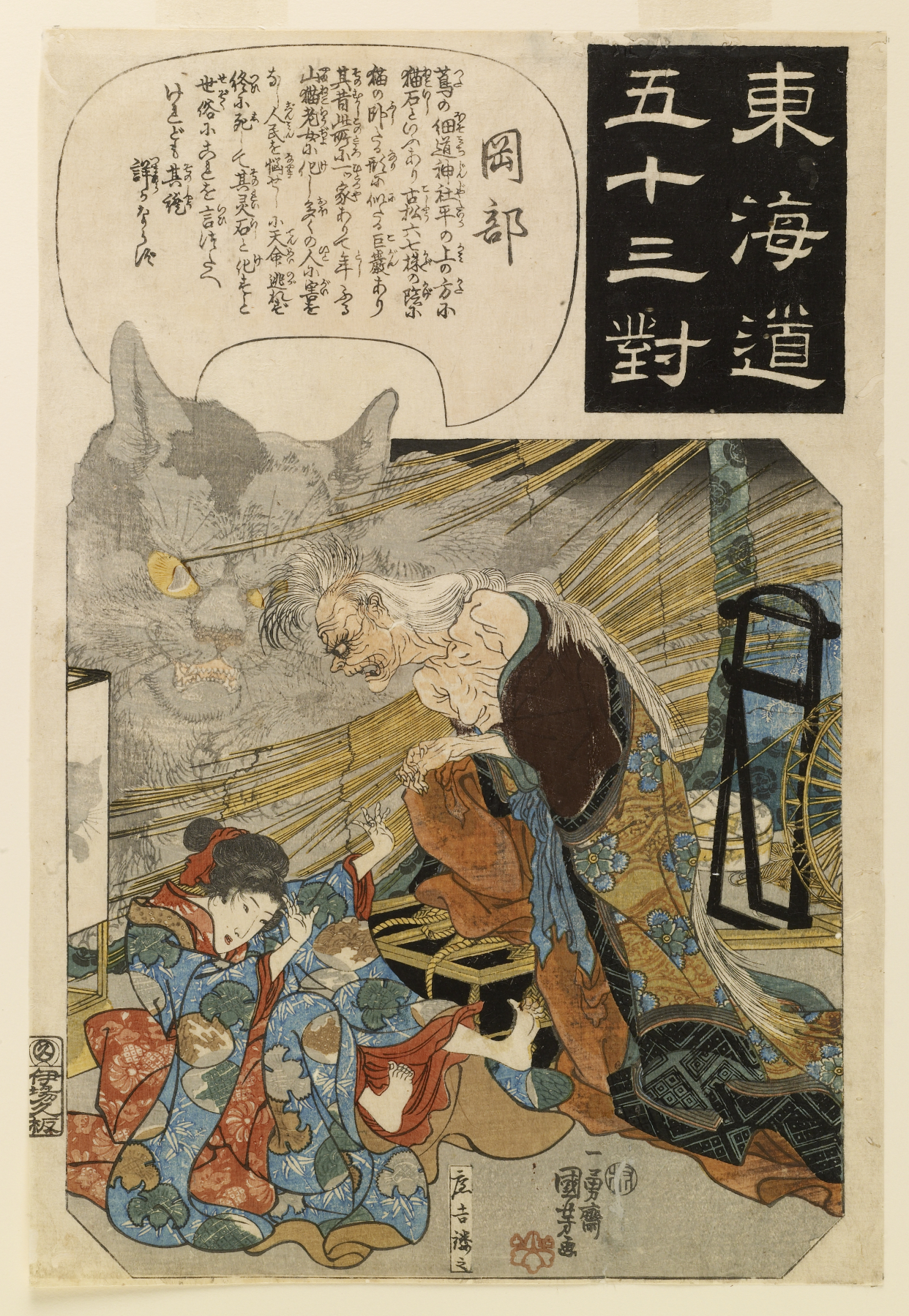
According to legend, there was an old witch living along the Tokaido road who would assume the shape of a giant cat in order to waylay young women who were visiting a local shrine.
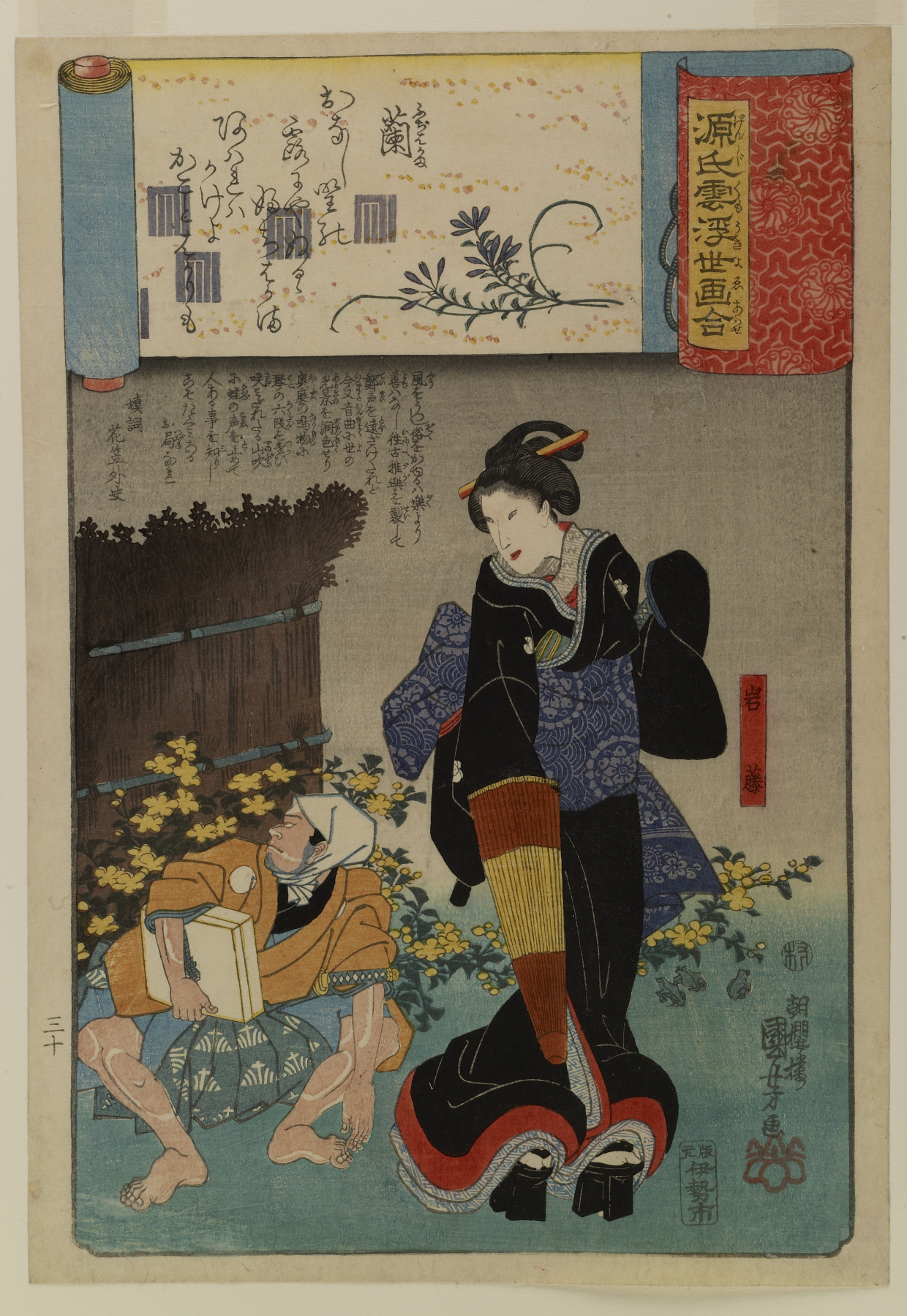
The evil lady-in-waiting Iwafuji plots to kill the shogun in the play “Kagamiyama kokyo no nishikie” (“The Women’s Chushingura”). This chapter of “The Tale of Genji” also concerns ladies-in-waiting and divided loyalties at the court.
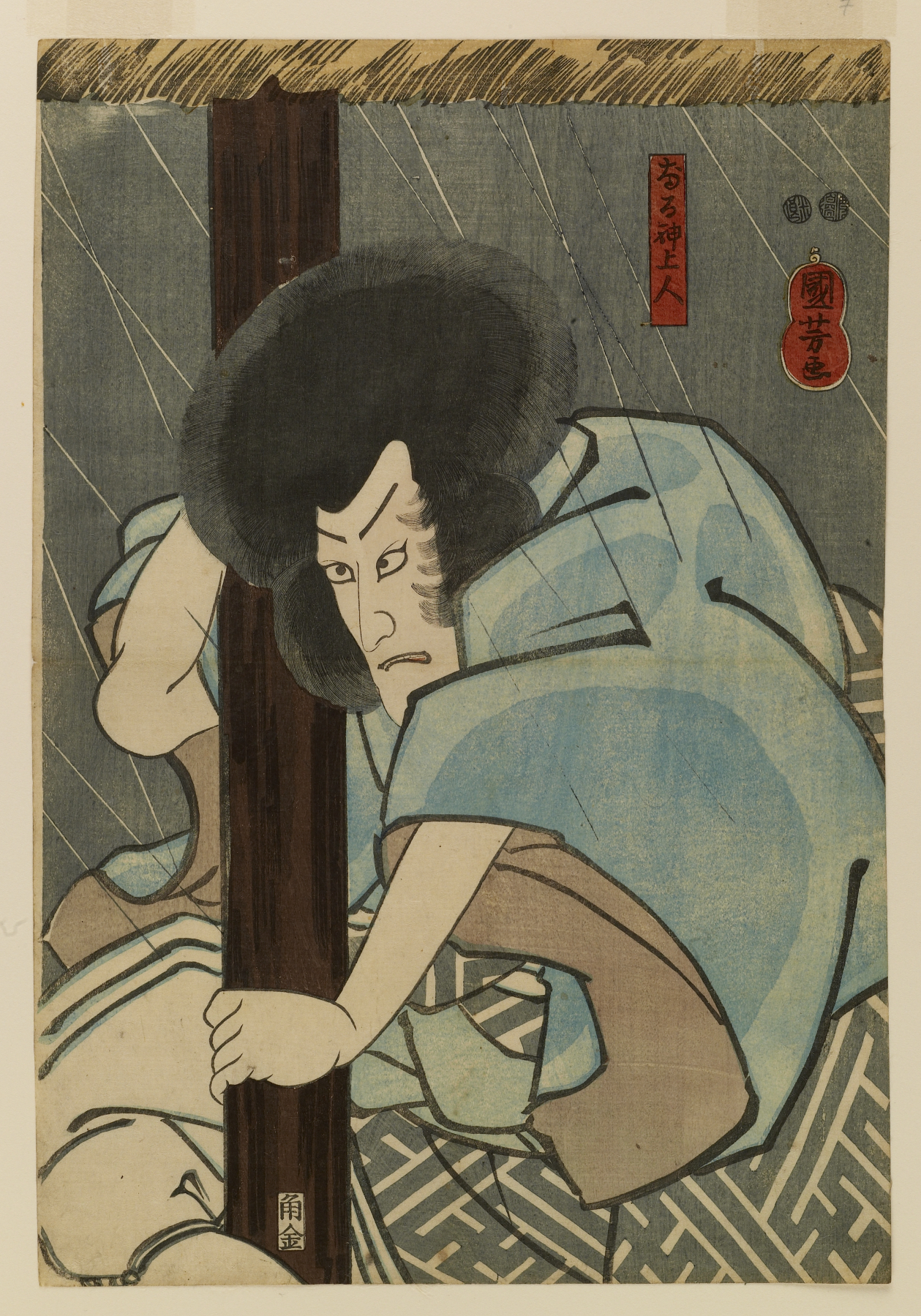
The evil priest Narukami grasps a pole in a pose of anger as rain slashes through the sky. Because of his grudge against the emperor, he had imprisoned the dragon god of rain and brought about a severe drought. The court sent a beautiful princess to seduce Narukami and make him drunk. She quickly released the rain god, who mounted to heaven with a cloudburst that make Narukami come to his senses in a howling rage.
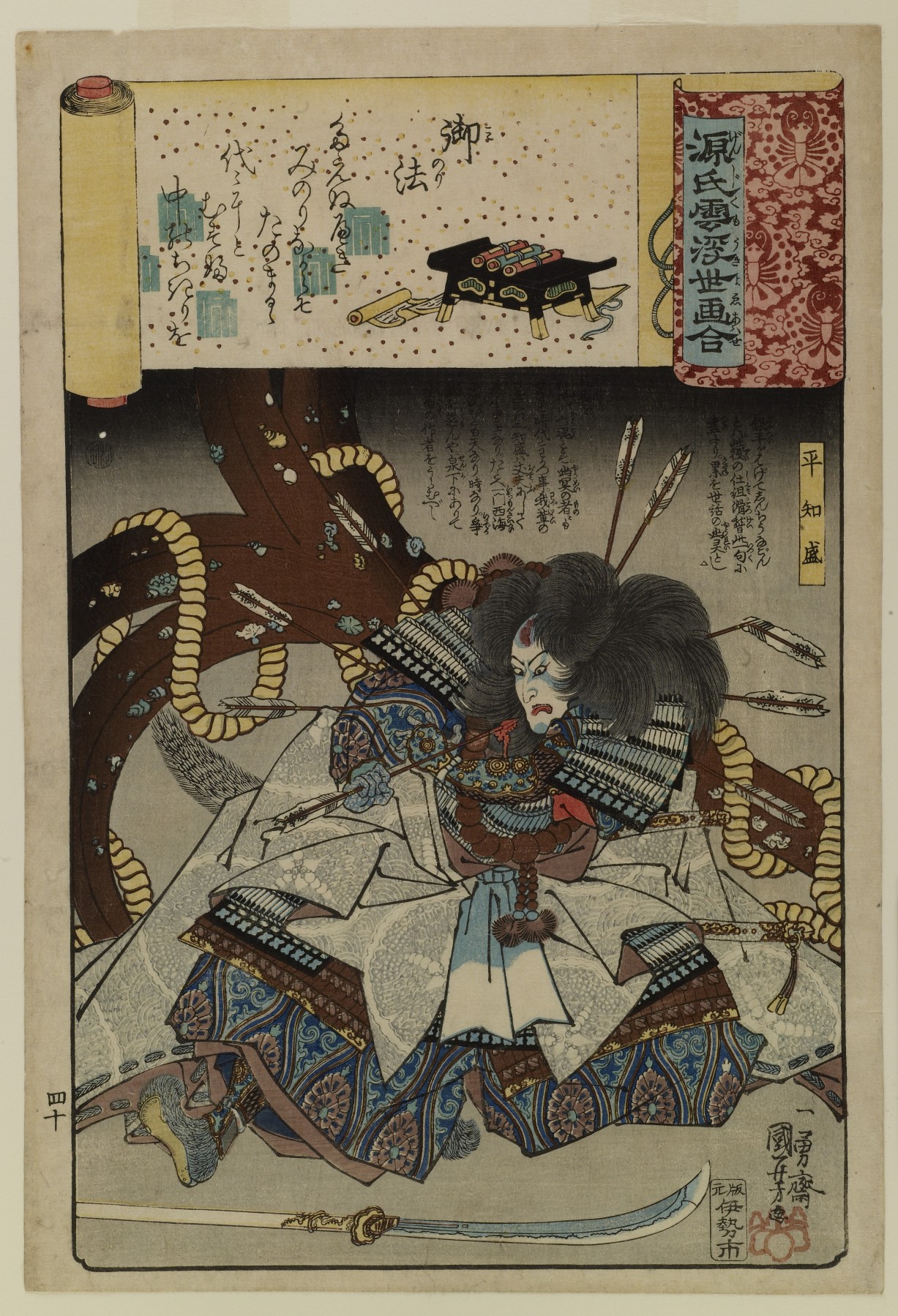
The great 12th-century general Taira no Tomomori ties himself to an anchor so that he may die by his own hand and not from enemy action as defeat nears in the famous sea battle at Dan-no-ura (1185). In “The Tale of Genji,” as her death approaches, Lady Murasaki insists on making the arrangements for her own funeral rites.
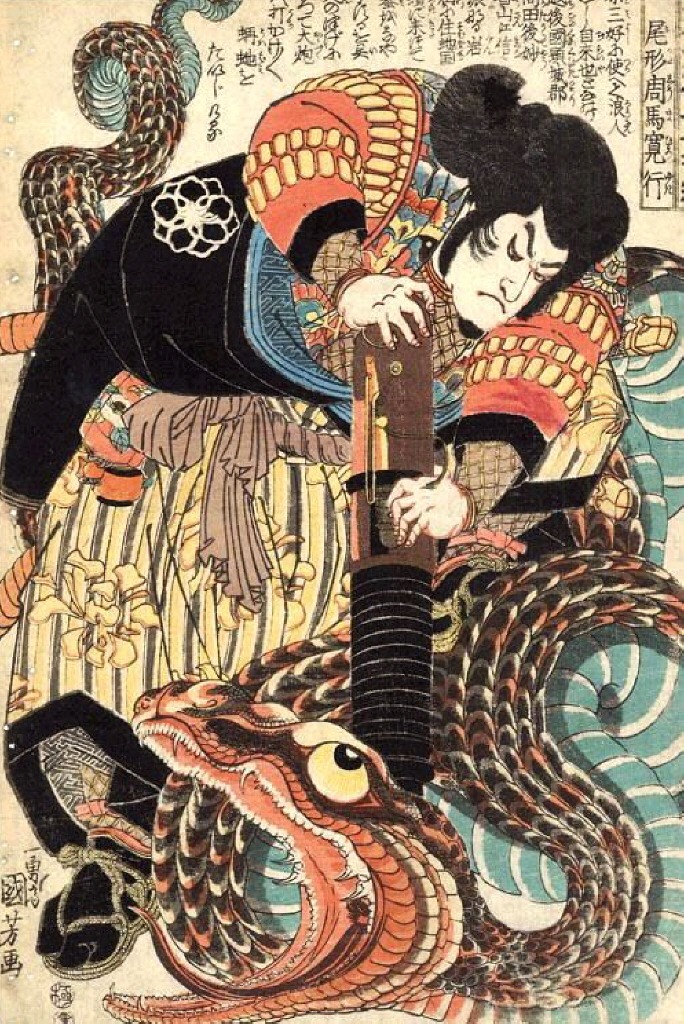
Ogata Shuma Hiroyuki later known as Jiraiya , with a heavy gun, overcoming a huge Snake which has preyed on his friends the Toads. Jiraiya is portrayed as being a ninja.

Hangan, dressed in the white robe of death, thrusts his dagger into his gut: this is ritual suicide by disembowelment, known as “seppuku.” His loyal retainer Yuranosuke rushes to his side to keep him from falling over. As Hangan completes his task he tells Yuranosuke that with this dagger he must avenge his death. They are surrounded by official witnesses, one of whom carries the shogun’s order for Hangan’s death.
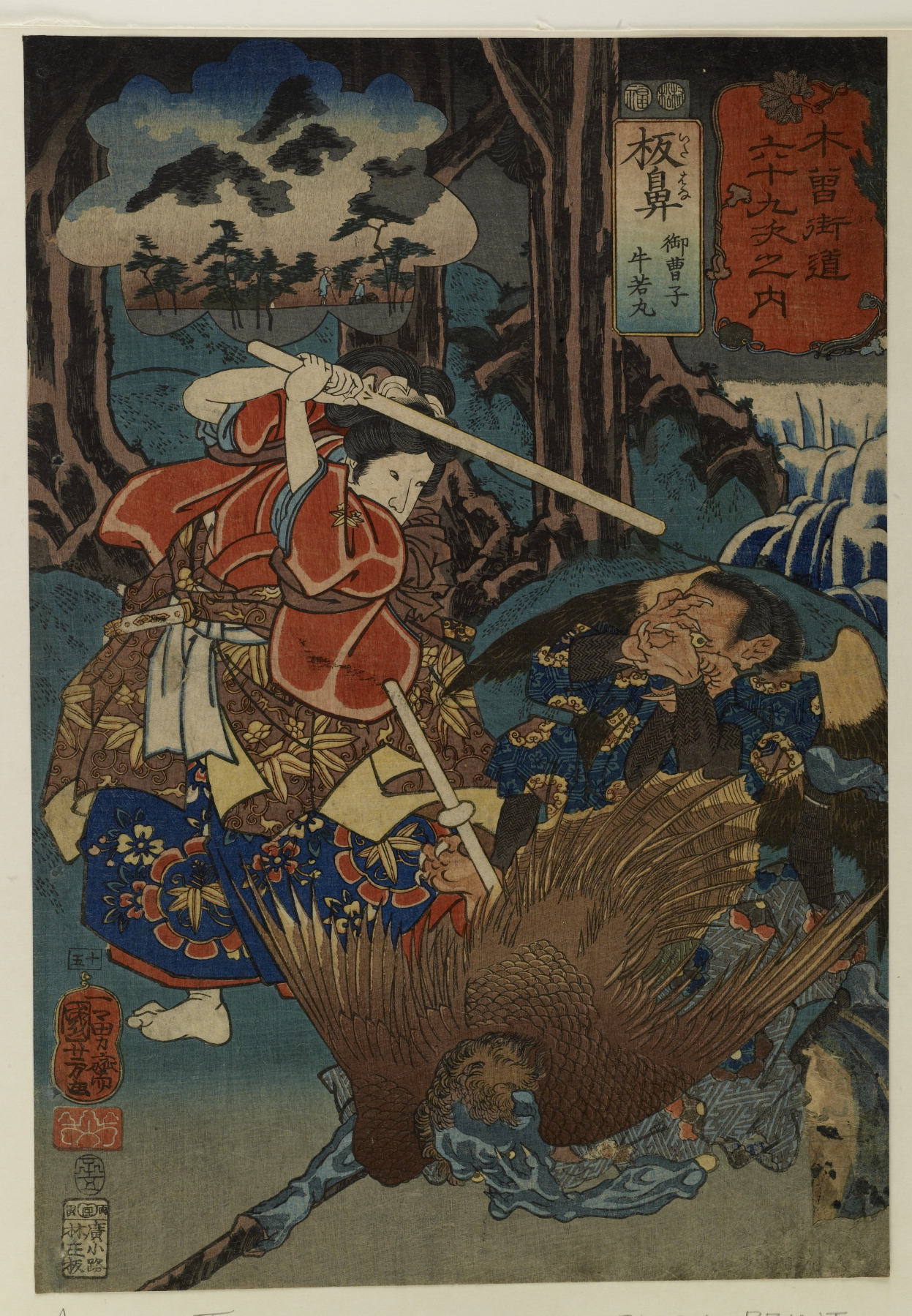
Ushiwakamaru (Yoshitsune as a young boy) is fencing with tengu, a long nosed goblin, using wooden swords near Mount Kurimu near Kyoto.

This print depicts Kume no Heizaemon with candles on his head. Matsuwaka Maru or Yoshida Matsuwaka is at the top.
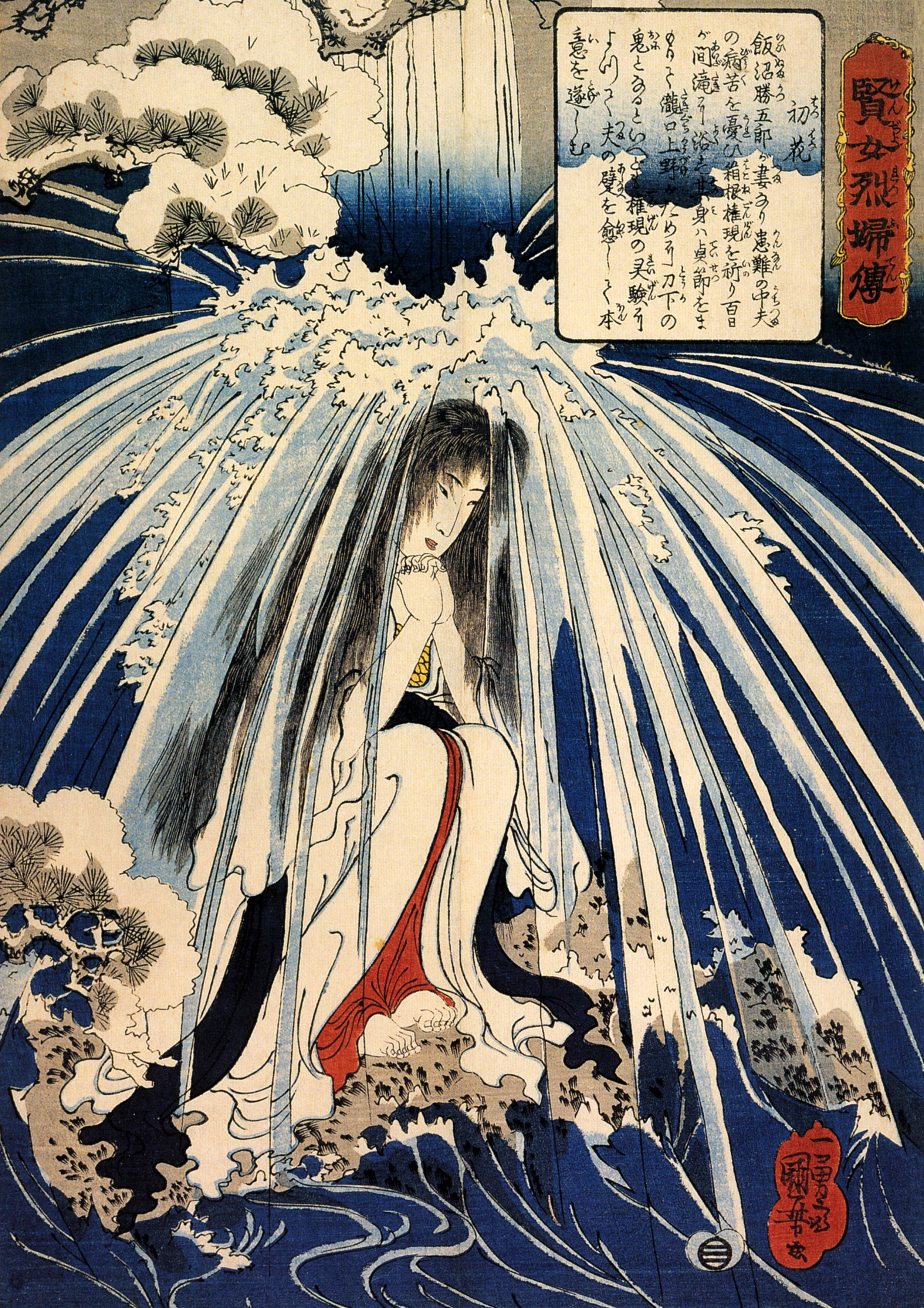
This print illustrates Hatsuhana (初花) doing penance under the Tonozawa waterfall for the cure of her son s knee, until the austerities killed her.
Miraculously cured Hatsuhana son seeks revenge killing his arc-enemy near the waterfall.
Via: The Walters Museum, Museum of Fine Arts, BizarreGrotesque
Would you like to support Flashbak?
Please consider making a donation to our site. We don't want to rely on ads to bring you the best of visual culture. You can also support us by signing up to our Mailing List. And you can also follow us on Facebook, Instagram and Twitter. For great art and culture delivered to your door, visit our shop.

